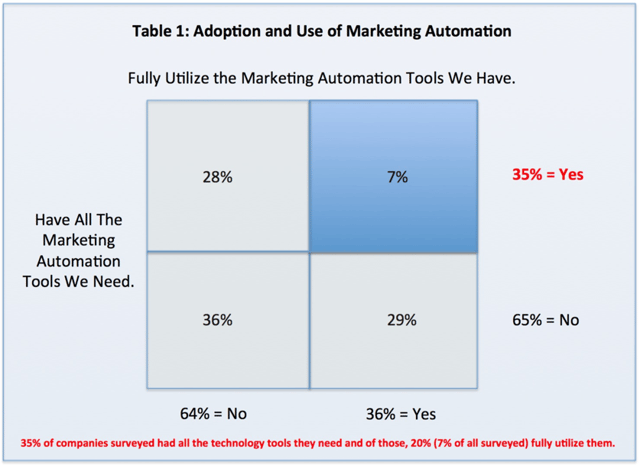Marketing automation fuels new approaches to create a better customer experience & ROI

For years we marketers have used large-scale email and web-based publishing to reach customers. More recently, we’ve added social media and mobile channels to our marketing ecosystem. Today we have “Marketing Automation,” or MA, a set of technologies ushering in new approaches to marketing. So just what is MA, and how can it grow your business? This post will examine a definition of contemporary MA and look at approaches to tie things together in a logical manner to help you achieve your goals.
Imagine a potential customer comes to your website via a Tweet and spends some time reading blog posts, downloading material and watching videos. As a result, they automatically receive a series of 12 emails with three targeted offers for a discount or more information. As their actions increase — indicating they are likely to buy — your phone system dials their number and connects them with a representative of your company to answer questions and advise them on their options. Their order is prepared, and they can either check out on their own, or use an online ROI calculator and speak to a rep well-versed in their “buyer’s journey” to close the deal.
You can see by this scenario that these technologies leverage customer intelligence, improve interactions across communication channels and monitor and respond to changes in customer behaviors based on workflow rules you establish. But is this realistic? Do companies really implement this level of Marketing Automation?
The short answer is yes; some do, but not all. Marketing Automation has grown into a billion-dollar industry in the business-to-business market alone by offering lower unit labor costs, better resource allocation and the ability to more cost-effectively scale operations. Some of the core MA system capabilities include:
- Centralized marketing database
- Native CRM integration
- Email marketing and list management
- Landing page development
- Website visitor tracking
- Lead management (ex. capture, score and nurture)
- Management reporting and data analysis
Advanced capabilities and functions that leverage data to deliver more customer-centric marketing include:
- Social listening, publishing, and profile integration
- Multi-channel campaign management
- Online adcampaign managementand optimization
- Dynamic content for website, landing pages & email based on customer attributes
- A “mobile-first” approach to adapt content to whichever device a person is using
- Personalized marketing through predictive analytics
- ISV ecosystem for app marketplace or API integration
- Project management and workflow tools
Early Adoption
Many companies do not use Marketing Automation at all yet, let alone effectively. Although market penetration has extended from innovators to early adopters — the sector has yet to reach maturity. This implies room for growth in both ease of use and capabilities, as a majority of companies still employ more traditional marketing tactics (e.g., email and affiliate marketing) and have not fully implemented automation for such integrated marketing efforts. The vast number of business-to-business marketers is still figuring out which of the many available tools is right for their business or how to optimize the use of automation systems already in place.

Source: Marketing Automation MARKET INTELLIGENCE REPORT: B2B Marketing Automation Platforms: A Marketer’s Guide, Third Door Media, Inc., 2016
According to the 2016 Marketing Technology Adoption Survey Report conducted by Dotmailer, 26% of marketing professionals surveyed are using Marketing Automation this year, while 36% are assigning budget to Marketing Automation in 2017.
The survey also presents the major challenges encountered by marketers: time and resources. The lack of skilled or experienced MA professionals is one inhibitor, as this kind of marketing is a bit of a left-brain/right-brain dichotomy. Configuring marketing automation requires knowledge and expertise in order to bring desired results and make campaigns run ‘on autopilot’. These skills have to be blended with the more creative endeavors traditionally associated with demand and lead generation teams.
To overcome these challenges marketers must learn to design and build seamless customer lifecycle-nurturing workflows to meet their unique sales and business objectives. A closed loop system that ties MA to either the CRM or e-commerce system — or both — is required for success. Quality data gathered from such tightly integrated systems maximizes opportunities by offering marketers better customer insights and information used to make customer-related decisions and drive revenue. This also gives businesses a more complete picture of marketing activities across multiple channels to maximize the attribution of marketing dollars to sales results.
Three Distinct Approaches
Marketing Automation powers three approaches. Marketers use these techniques to effectively attract, engage, convert and delight their customers.
Content Marketing. The audience goal is to be informative and provide thought leadership, while attribution is not a core focus. Content marketing is a method that refers to the various types of content — blogs, e-books, infographics, podcasts, videos, white papers, etc. — created to fuel the marketing program, versus other inbound approaches like SEO and Social Media. It is sometimes referred to as “brand journalism.”
Inbound Marketing. The key to successful Inbound Marketing is to serve relevant content offers with clear calls-to-action to a target audience using preferred channels at a chosen frequency. Inbound is highly dependent on being “found” on search engines and social media channels. Pioneered by HubSpot almost 10 years ago, Inbound Marketing uses blogging and posting social media updates for targeted mass consumption but is not as intrusive as outbound techniques. A core objective is attribution of marketing activity to sales results. Brands publish to attract as many qualified leads as possible and move them along the purchasing stages.
Account-Based Marketing. This is a strategic B2B marketing approach that connects deeply-personalized marketing and sales activities to create new opportunities and deepen engagement/relationships with a set of target accounts. Unlike Inbound Marketing, the universe of customers is known. Each account is treated as its own market, where marketers identify influencers and decision-makers as part of a coordinated campaign. Marketing Automation vendors like Act-On now provide account-level views and lead scoring and nurturing to give marketing teams a single view of an account’s buying team.
Inbound Journalism Brings a Voice to All Three
One content style that is gaining favor is to use journalism as the ethos underlying all the content publishing activities required to benefit from Marketing Automation. The theory being, the best way to sell products and engage markets today is to report on them. Journalism builds trust by focusing on facts and a truth about the facts. Austin Lawrence has developed this concept to orchestrate content development for the three marketing approaches by creating a methodology, or framework, called Inbound Journalism to help companies succeed in meeting their revenue, profit and customer growth goals.
Whether on your own branded site, or as a stand-alone (off-domain) news property, like Chief Packaging Officer or CMO.com, huge opportunities exist from the use of journalistic publishing for demand generation. Companies that think like publishers and brands that own news media properties can operate as both advertiser and publisher.
The intrinsic benefits of Inbound Journalism include:
- Unique competitive advantage
- Peer status with traditional media
- An ability to build relationships across customary boundries such as, colleagues, competitors and influencers.
These are the six key elements for effective Inbound Journalism that deliver business results:
- A big, "North Star" idea.
- Thought leadership; develop a pioneering concept; what’s the driving purpose? How do you connect to your buyer personas?
- A plan for demand generation and an ROI Model to evaluate the business case.
- A journalism-based editorial strategy that connects with buyers.
- Make the content significant, interesting and relevant to identified personas.
- Tell stories with a purpose
- Use of a closed loop strategy as described above to achieve business goals.
- Manage content and craft online experience
- Evaluate results
- A sustainable publishing process to promote efforts and grow audience.
- The business side of publishing
- Distribution of content & marketing partnerships
- Sales team training and technology enablement.
- Manage MQL to SQL leads
- Train on Inbound leads handling
- Get sales team to blog and distribute content
Think Like a Publisher or Perish
If you don’t get into the brand publishing game, it’s likely your competition soon will. B2B marketers with traditional marketing experience are being pushed to take more advanced Marketing Automation approaches. Consumer marketers with higher price points and longer consideration cycles can also benefit from these techniques. Marketing Automation providers developing more user-friendly systems to help marketers maximize the features of their technology platforms will help in this regard.
Marketing Automation powers three distinctly different approaches to audience building. It is critical to set key performance indicators and ROI goals when implementing these new systems. Automation of repetitive tasks can reduce labor, enhance brand consistency and improve responsiveness to customer online behavior. The Holy Grail is to provide customers a more satisfying online experience as a competitive differentiator to help you increase revenues and grow market share.
As you contemplate investing in a fully integrated Marketing Automation strategy, Inbound Journalism offers your brand a framework to leverage age-old news and thought leadership publishing techniques for building your audience. No matter the marketing approach and content strategy you choose, designing an automation framework to power your digital marketing solution is critical. Selecting the right software and installing workflows impacts lead management and sales productivity, which in turn will determine the success of your Marketing Automation technology initiative.
PLAYBACK: How To Build Your Lead Generation Into Your Content and Engagement Plans
This article was written by Keith R. Reynolds. Keith is a speaker, writer, marketeer & solution strategist at Austin Lawrence Group, a B2B Inbound agency located in the NY-Tristate area. Keith is a twenty-five-year technology industry veteran. The core of his effort is to build a practice focused on the discipline of Inbound Journalism and provide strategic guidance for clients. He is also responsible for taking Austin Lawrence's growing technology partnerships to the next level. He can be reached at: kr@austinlawrence.com or on Twitter @maximfuel.








